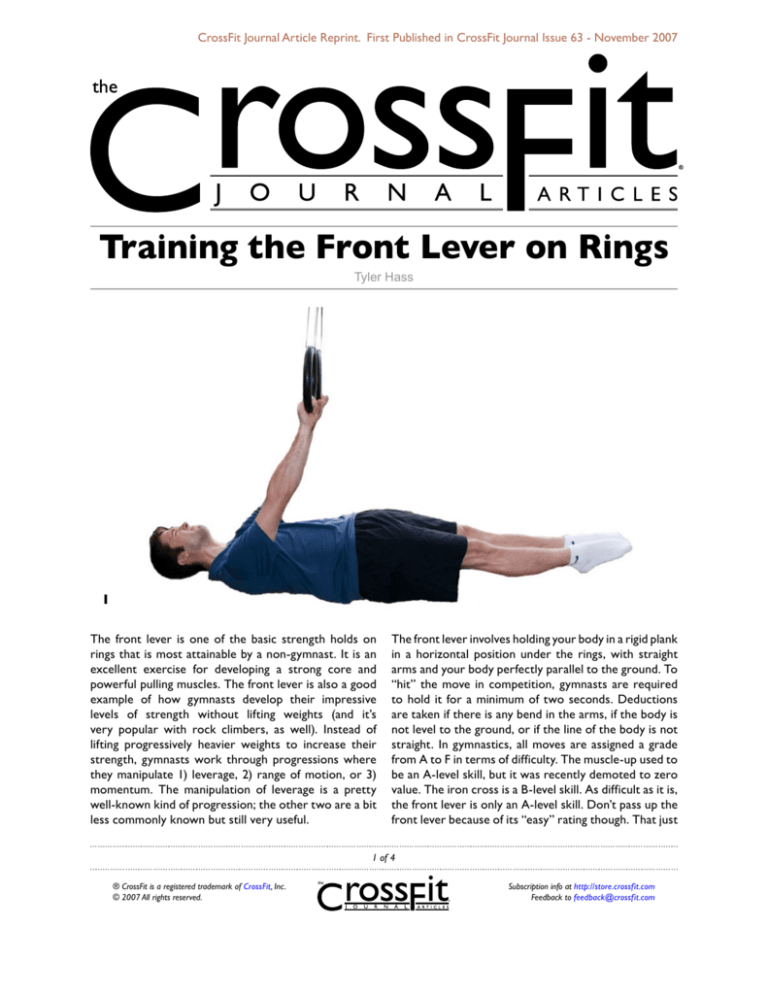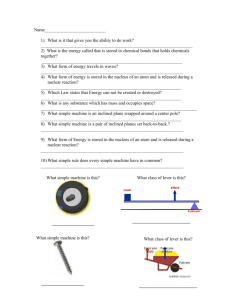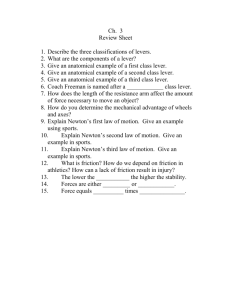
CrossFit Journal Article Reprint. First Published in CrossFit Journal Issue 63 - November 2007
Training the Front Lever on Rings
Tyler Hass
1
The front lever is one of the basic strength holds on
rings that is most attainable by a non-gymnast. It is an
excellent exercise for developing a strong core and
powerful pulling muscles. The front lever is also a good
example of how gymnasts develop their impressive
levels of strength without lifting weights (and it’s
very popular with rock climbers, as well). Instead of
lifting progressively heavier weights to increase their
strength, gymnasts work through progressions where
they manipulate 1) leverage, 2) range of motion, or 3)
momentum. The manipulation of leverage is a pretty
well-known kind of progression; the other two are a bit
less commonly known but still very useful.
The front lever involves holding your body in a rigid plank
in a horizontal position under the rings, with straight
arms and your body perfectly parallel to the ground. To
“hit” the move in competition, gymnasts are required
to hold it for a minimum of two seconds. Deductions
are taken if there is any bend in the arms, if the body is
not level to the ground, or if the line of the body is not
straight. In gymnastics, all moves are assigned a grade
from A to F in terms of difficulty. The muscle-up used to
be an A-level skill, but it was recently demoted to zero
value. The iron cross is a B-level skill. As difficult as it is,
the front lever is only an A-level skill. Don’t pass up the
front lever because of its “easy” rating though. That just
of 4
® CrossFit is a registered trademark of CrossFit, Inc.
© 2007 All rights reserved.
Subscription info at http://store.crossfit.com
Feedback to feedback@crossfit.com
Training the Front Lever on Rings (continued...)
goes to show how insanely difficult gymnastics really
is. The lever is very challenging, especially if you don’t
have the body type of a typical gymnast (i.e., small and
light). Your reward will be greater upper-body and core
strength, which will carry over to pull-ups, L-sits, and a
whole variety of other, seemingly unrelated exercises.
The technique of the front lever is simple to describe
but difficult to master. The main requirement is total
body tension. It is especially important to keep your
glutes and abs tight. This not only ensures a straight
body line, but it also boosts your strength throughout
your body. With a solid platform in place, your lats,
shoulders, triceps and back muscles can do their job
as the prime movers. A false grip is not necessary for
a front lever and can actually make it more difficult for
most people. You can just hold the rings normally with
a firm grip. Keep constant pressure on the rings by
trying to pull them downward toward your hips, which
will activate your lats. It can also help to pull the rings
together, which will activate the muscles of your chest
and help lock your arms into your lats.
2
Training for the front lever is also considerably safer
for your joints than learning some of the other highlevel strength skills, such as the iron cross or maltese,
because you are not supporting your weight on top of
locked elbow joints. The front lever is not too hard
on the body. But because training for the front lever
means that you will be hanging upside down, I would
recommend having something soft underneath you and
to make sure your hands and the rings are not sweaty.
And don’t let go when you’re upside down. I’ve never
had to tell anyone that more than once!
3
The leverage progression
The front lever is difficult because you have to support
your entire bodyweight at the shoulder joint alone.
Your body provides lots of resistance in the form of a
very long lever arm; the longer the lever, the greater the
resistance. But the opposite is also true. If you shorten
the lever, you can reduce the resistance. This is our
first method of training for the front lever. By pulling in
your legs until your knees touch your chest, into what is
called a tucked position, you can significantly reduce the
leverage you have to work against (photo 2).
The next step is to get into the tuck position below the
rings and then extend one leg straight out (photo 3). The
idea is to create an incremental increase in resistance
4
by gradually extending the one foot farther out from
your body. At first, your foot should be close to your
hip. Once you can hold this position, try moving the
foot our farther, and farther, until eventually you can
hold it straight and in line with your body. Then begin
gradually moving the other foot out in the same manner,
moving the foot closer to the knee of your straight leg,
then the calf, then the ankle (photo 4). This is another
incremental increase in resistance.
of 4
® CrossFit is a registered trademark of CrossFit, Inc.
© 2007 All rights reserved.
Subscription info at http://store.crossfit.com
Feedback to feedback@crossfit.com
Training the Front Lever on Rings (continued...)
Some coaches use the straddle front lever in the
teaching progression instead of the one-leg extended
version. Both provide a lower-leverage version of the
move you can use to build strength and technique on
your way to the full skill. I learned my progression from
Brad Johnson, who is a very strong former gymnast. He
can hold a one-armed front lever with a dumbbell in the
other hand! I prefer this progression for non-gymnasts,
because unless you can do the splits, the straddle front
lever is more of a hindrance to achieving progress. If you
have good flexibility, give the straddle lever a try. If not,
you can make good progress without it.
The range-of-motion progression
Another way to train for the front lever is to work in
a shorter range of motion. Start in an inverted hang
(hanging upside down, with toes pointed toward the
ceiling, straight arms, and a straight, rigid body position)
and then lower yourself down toward the front lever
position with a straight body and legs extended. Go
down as far as you can under control and then pull back
into an inverted hang. This is one rep. At first, you will
probably be able to lower your body a few inches before
you have to pull back up into the inverted position. Over
time, you will develop the ability to get your body closer
and closer to parallel with the floor.
Another method, first taught to me by Coach
Glassman, is to work on lowering yourself all the way
down as slowly as possible. This is called a negative
and it is commonly used to learn the front lever and
other, higher-level strength moves. To do it, get into
an inverted hang and then, with straight arms, lower
your straight, planked body as slowly as possible toward
parallel with the ground (photo 5). At some point you
will lack the strength and your body will fall back down
into a hang. Get yourself back up into an inverted hang
in whatever way you can and then perform another full
negative. Keep doing reps until you are basically in a free
fall on the way down. This exercise also provides a great
anatomy lesson: the next day, you will know exactly
where your lats are!
The momentum progression
The final method is to use momentum to get yourself
into the full front lever position, hold it for as long as
possible, and then swing your way back. I learned this
exercise from world champion and four-time Olympian,
Jordan Jovtchev when I asked if he had any cool front
lever exercises. I was pretty amazed with what he came
up with. This exercise is cutely named the ice cream
maker. A lot of really hard exercises have cute names,
because only gymnasts can do them, and most gymnasts
(unfortunately) in this day and age are children.
To perform an ice cream maker, first do a pull-up and
then, at the top of the pull-up, push your body straight
back and you will swing into the front lever position.
Hold it for as long as possible and then swing back to
the top position of the pull-up. Swing again to the front
lever position and hold. To get your swing going, you
need to push your upper body away from the rings and
simultaneously pull down on the rings (photo 6). It takes
a while to get the rhythm of this exercise, but once you
do, it is a very smooth movement.
This is a great exercise for doing high reps, especially
once you get the rhythm. It can also be a fun substitute
for pull-ups in a workout like “Helen” or “Fran.”
Training for the front lever
There is no right or wrong way to train for the front lever.
For the typical CrossFit athlete, it will be difficult to train
the same way as a gymnast would. What I recommend
is doing a small amount of work very frequently at the
end of your warm-up. On CrossFit’s strength days, you
can do a bit more work on it after you’ve done the
exercises from the workout of the day.
5
of 4
® CrossFit is a registered trademark of CrossFit, Inc.
© 2007 All rights reserved.
Subscription info at http://store.crossfit.com
Feedback to feedback@crossfit.com
Training the Front Lever on Rings (continued...)
6
I also recommend working step by step through the
three progressions I’ve outlined. First work with the
leverage progression for a month or two. Holds of
five to ten seconds are sufficient, although you can go
longer earlier on. As soon as you are able to support
yourself in a position, move up to the next hold in the
progression. Some people recommend not moving up
to the next step until you can hold the previous one for
30 to 60 seconds, but I think most people can progress
faster than that. Three to five holds per workout is a
good amount.
When you get to the point where you can hold the
position with one leg extended and the other foot at
your knee, then it’s probably time to switch over to the
momentum progression. I really like the negatives that
Coach Glassman recommends. They are a very potent
stimulus and you can make great progress with them.
It’s great for breaking through that final plateau.
Then, after training for two to three weeks on negatives,
switch to the momentum progression. The ice cream
maker is great because it lets you get the feel of a full
front lever, even if it’s only for half a second. The key is
learning how to generate a high amount of body tension
in the front lever position.
many pull-ups can you do?” My recommendation is to
train the front lever as early as you want, but not to
expect great progress until you can do about fifteen
kipping pull-ups and one weighted dead hang pull-up
with about 20 percent of your bodyweight. This is just
basic upper-body strength. Expecting quick progress
on advanced gymnastics moves without even a basic
foundation of strength is pretty silly. The best correlate
I have found for front lever performance is the weighted
pull-up. I’ve seen several people get the front lever on
the first try without ever training for it. The one thing
they have had in common is training weighted pull-ups.
Most of them could do a few pull-ups with an extra 80
to 90 pounds (roughly 50 to 60 percent of bodyweight).
If your progress stalls on the front lever, give it a rest
and train weighted pull-ups for a while.
I don’t want to discourage anyone from getting started
with the front lever, though. It’s a safe move to train, it’s
really fun, and it gives you a nice taste of what gymnasts
do to get strong.
Once you are able to front levers, you can maintain
the ability by subbing ice cream makers for pull-ups
occasionally and by doing front lever holds on strength
days and occasionally in your warm-up.
Are you ready for the front lever?
I receive a lot of e-mails from people who have followed
a front lever progression for several months and made
almost no progress. My first question is always “How
Tyler Hass is the founder of ringtraining.com
and designer and producer of the Elite Rings. His
company is dedicated to spreading gymnastics
into the broader fitness world. He can be
reached at info@ringtraining.com.
of 4
® CrossFit is a registered trademark of CrossFit, Inc.
© 2007 All rights reserved.
Subscription info at http://store.crossfit.com
Feedback to feedback@crossfit.com








